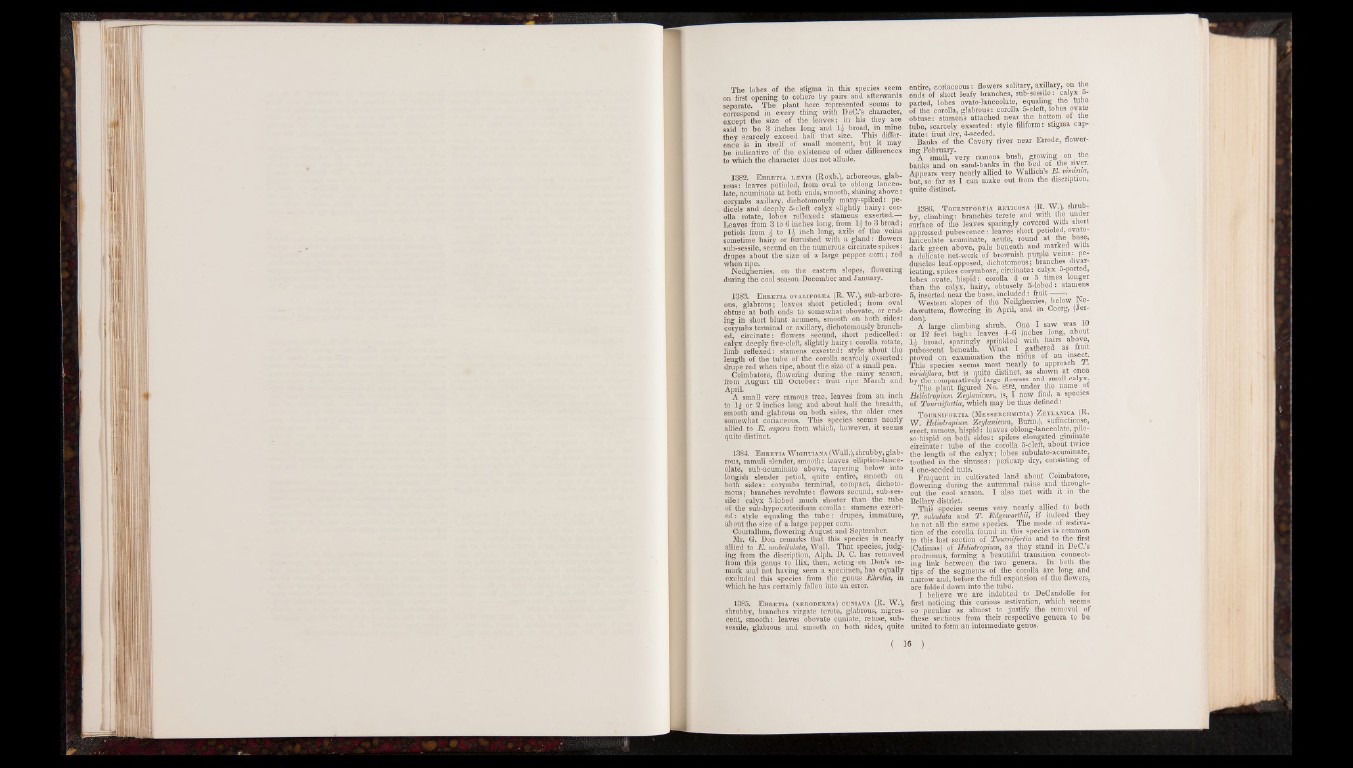
The lobes of the stigma in this species seem
on first opening to cohere by pairs and afterwards
separate. The plant here represented seems to
correspond in every thing with DeC.’s character,
except the size of the leaves; in his they are
said to be 3 inches long and l£ broad, in mine
they scarcely exceed half that size. This difference
is in itself of small moment, but it may
be indicative of the existence of other differences
to which the character does not allude.
1382. Ehretia LiEvis (Roxb.), arboreous, glabrous:
leaves petioled, from oval to oblong lanceolate,
acuminate at both ends, smooth, shining above:
corymbs axillary, dichotomously many-spiked: pedicels
and deeply 5-cleft calyx slightly hairy: corolla
rotate, lobes reflexed: stamens exserted.—
Leaves from 3 to 6 inches long, from 1^ to 3 broad;
petiols from £ to 1A inch long, axils of the veins
sometime hairy or furnished with a gland: flowers
sub-sessile, secund on the numerous circinate spikes:
drupes about the size of a large pepper corn; red
when ripe.
Neilgherries, on the eastern slopes, flowering
during the cool season December and January.
1383. Ehretia ovalifolea (R. W.), sub-arboreous,
glabrous; leaves short petioled; from oval
obtuse at both ends to somewhat obovate, or ending
in short blunt acumen, smooth on both sides:
corymbs terminal or axillary, dichotomously branched,
circinate: flowers secund, short pedicelled:
calyx deeply five-cleft, slightly hairy: corolla rotate,
limb reflexed: stamens exserted: style about the
length o f the tube of the corolla scarcely exserted:
drupe red when ripe, about the size of a small pea.
Coimbatore, flowering during the rainy season,
from August till October: fruit ripe March and
April.
A small very ramous tree, leaves from an inch
to l£ or 2 inches long and about half the breadth,
smooth and glabrous on both sides, the older ones
somewhat coriaceous. This species seems nearly
allied to E . aspera from which, however, it seems
quite distinct.
1384. Ehretia W ightiana (Wall.), shrubby, glabrous,
ramuli slender, smooth: leaves elliptico-iance-
olate, sub-acuminate above, tapering below into
longish slender petiol, quite entire, smooth on
both sides: corymbs terminal, compact, dichotomous;
branches revolute: flowers secund, sub-sessile:
calyx 5-lobed much shorter than the tube
of the sub-hypocarteriform corolla: stamens exserted:
style equaling the tube: drupes, immature,
abotit the size of a large pepper com.
Courtallum, flowering August and September.
Mr. G. Don remarks that this species is nearly
allied to E . umbellulata, Wall. That species, judging
from the discription, Alph. D. C. has removed
from this genus to Ilix, then, acting on Don’s remark
and not having seen a specimen, has equally
excluded this species from the genus Ehretia, in
which he has certainly fallen into an error.
1385. Ehretia (xeroderma) cuniata (R. W.),'
shrubby, branches virgate terete, glabrous, nigrescent,
smooth: leaves obovate cuniate, retuse, sub-
sessile, glabrous and smooth on both sides, quite
entire, coriaceous: flowers solitary, axillary, on the
ends of short leafy branches, sub-sessile: calyx 5-
parted, lobes ovato-lanceolate, equaling the tube
of the corolla, glabrous: corolla 5-cleft, lobes ovate
obtuse: stamens attached near the bottom of the
tube, scarcely exserted: style filiform: stigma capitate:
fruit dry, 4-seeded.
Banks of the Cavery river near Errode, flowering
February. .
A small, very ramous bush, growing on tne
banks and on sand-banks in the bed of the river.
Appears very nearly allied to Wallich’s E . yiminia,
but, so far as I can make out from the discription,
quite distinct.
1386. T ournifortia reticosa (R. W.), shrubby,
climbing: branchés terete and with the under
surface of the leaves sparingly covered with short
appressed pubescence: leaves short petioled, ovato-
lanceolate acuminate, acute, round .at the base,
dark green above, pale beneath and marked witn
a delicate net-work of brownish purple v ein s: peduncles
leaf-opposed, dichotomous; branches divaricating,
spikes corymbose, circinate: calyx 5-parted,
lobes ovate, hispid: corolla 4 or 5 times longer
than the calyx, hairy, obtusely 5-lobed: stamens
5, inserted near the base, included: fruit — —.
Western slopes of the Neilgherries, below Ne-
dawuttem, flowering in April, and in Coorg, (Jer-
don). ^
A large climbing shrub. One I saw was 1U
or 12 feet high: leaves 4 -6 inches long, about
] i broad, sparingly sprinkled with hairs above,
pubescent beneath. What I gathered as fruit
proved on examination the nidus of an 1^se^*
This species seems most nearly to approach 1 .
viridiflora, but is quite distinct, as shown at once
by the comparatively large flowers and small calyx.
J mi sms C____J TVT« OHO tVlO ÏISIÏIB fit
T ournifortia (Messerchmidia) Z eylanica (R.
W. Heliotropium Zeylanicum, Burm.), suffricticose,
erect, ramous, hispid: leaves oblong-lanceolate, pilo-
so-hispid on both sides: spikes elongated giminate
circinate: tube of the corolla 5-cleft, about twice
the length of the calyx; lobes subulato-acuminate,
toothed in the sinuses: pericarp dry, consisting of
4 one-seeded nuts. _ . ,
Frequent in cultivated land about Coimbatore,
flowering during the autumnal rains and^ throughout
the cool season. I also met with it in the
Bellary district.
This species seems very nearly allied to both
T. subulata and T . Edgeworthii, if indeed they
be not all the same species. The mode of aestivation
of the corolla found in this species is common
to this last section of Tournifortia and to the first
(Catimas) of Heliotropium, as they stand in DeC.’s
prodromus, forming a beautiful transition connecting
link between the two genera. In both the
tips of the segments of the corolla are long and
narrow and, before the full expansion of the flowers,
are folded down into the tube.
I believe we are indebted to DeCandolle for
first noticing this curious aestivation, which seems
so peculiar as almost to justify the removal of
these sections from their respective genera to be
united to form an intermediate genus.